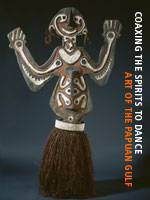Coaxing the spirits to dance – Art of the Papuan Gulf at the Metropolitan

Exhibition cover at the Metropolitan
© The Metropolitan Museum of Art, New York (www.metmuseum.org)
Art Traditions of Papuan Gulf Explored through Rare Objects and Photographs at the Metropolitan Museum
Press release from the Metropolitan Museum of Art informing about a new exhibition of Papuan Art
Exhibition dates: October 24, 2006 – September 2, 2007
Exhibition location: The Michael C. Rockefeller Wing
An exhibition of some 60 powerful and graphically elaborate sculptures and 30 rare historical photographs from the Papuan Gulf area of the island of New Guinea will go on view at The Metropolitan Museum of Art, beginning October 24. Featuring sacred objects as well as photographs, Coaxing the Spirits to Dance: Art of the Papuan Gulf will demonstrate how deeply embedded art was in the region’s social life in the late 19th and early 20th centuries. The exhibition is the first in-depth investigation of these art traditions in 45 years. Drawn from public and private collections, as well as the Museum’s own holdings, many of the works will be exhibited for the first time.
The exhibition was organized by the Hood Museum of Art, Dartmouth College, in collaboration with The Metropolitan Museum of Art, New York.
“This is the first comprehensive study of the material since the groundbreaking 1961 exhibition Art Styles of the Papuan Gulf at the Museum of Primitive Art,” said Virginia-Lee Webb, Research Curator in the Metropolitan Museum’s Department of the Arts of Africa, Oceania, and the Americas. “That exhibition was organized by the late Douglas Newton, who later became a curator at the Metropolitan Museum, when the Museum of Primitive Art’s collection transferred here. The current exhibition, Coaxing the Spirits to Dance, and its catalogue make important contributions to our knowledge of one of the major art traditions of the island of New Guinea, the world’s second largest island.”
Representing spirits in the form of masks, figures, and ancestor or spirit boards, the sculptures were used to cajole and coax supernatural beings to attend to human needs. The juxtaposition of rare photographic images with the objects – objects often specifically identifiable in the photographs – allows for a ready presentation of culturally specific ideas. The selection of historical photographs, taken by 19th- and 20th-century travelers to the Papuan Gulf, is primarily drawn from the Museum’s Photograph Study Collection in the Department of the Arts of Africa, Oceania, and the Americas.
The Papuan Gulf region extends for some 300 miles along the south coast of the independent nation of Papua New Guinea, from the Fly River in the west to Cape Possession in the east, about 100 miles northwest of Port Moresby, the modern, bustling national capital. Although its deltas or bayous make up the fourth largest of the country’s 20 provinces – an area about the size of Massachusetts, Connecticut, and Rhode Island combined – it is the second smallest province by population, with fewer than 100,000 inhabitants, and large parts of the inland rainforest are almost uninhabited.
The Papuan Gulf region comprises approximately five major groups of related peoples, each with its own stylistically distinct forms of masks, figures, and spirit boards. Nearly every object was created to communicate with or control the spirit world for the benefit of the family or community. Local sculptors were able to attract the spirits to live in the boards that were kept in shrines in the longhouses, the center of men’s community life, or to inhabit the masks and enable dancers to be activated by them during performances involving the entire community.
Among the objects on view, highlights include: a mask called hokore with a bold design depicting a gecko, a clan totem; a carved and painted spirit board called titi ebiha, with an image of a spirit in human form with asymmetrical legs animated in dance; and a masterfully carved wooden figure called agibe that celebrated Kerewa ancestors and the communal longhouse identity ensuring success in conflict. Highlights among the photographs are the Iriwake Figure in Longhouse (daima), recording the exceedingly rare sculpture called Iriwake – together for the first time in the exhibition – taken by Paul Baron de Rautenfeld (Swiss, 1865-1957) in Maiaki village on May 19, 1925; Young Men with Maiva Shields, 1881-1889, one of the earliest photographs documenting art from the Papuan Gulf, made by William Lawes (English, 1839-1907) between 1881 and 1889; and Masks, hevehe Dancing on Beach with Girls, February 1932, by Francis Edgar Williams (Australian, 1893-1943), capturing women dancing “with their arms held high like a flock of mountain birds” alongside towering hevehe masks, which represent sea spirits that have been placated and coaxed to dance.
The exhibition in New York is organized by Virginia-Lee Webb.
It will be accompanied by a catalogue with essays by Robert L. Welsch, Visiting Professor of Anthropology at Dartmouth College, Sebastian Haraha, Senior Technical Officer, Department of Anthropology, National Museum and Art Gallery, Papua New Guinea, and Virginia-Lee Webb.
A related Sunday at the Met Conference, with participation by international scholars, is planned for spring 2007, and a variety of educational programs will be offered concurrent with the exhibition, including gallery talks, family programs, and a screening of the documentary film The Mythic Camera of Frank Hurley.
The exhibition will also be featured on the Museum’s Web site at www.metmuseum.org.
Follow us on:


